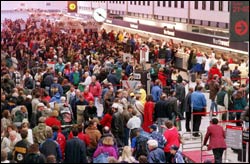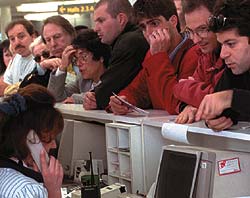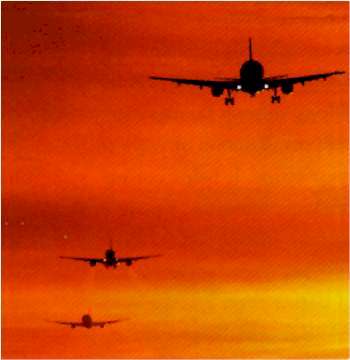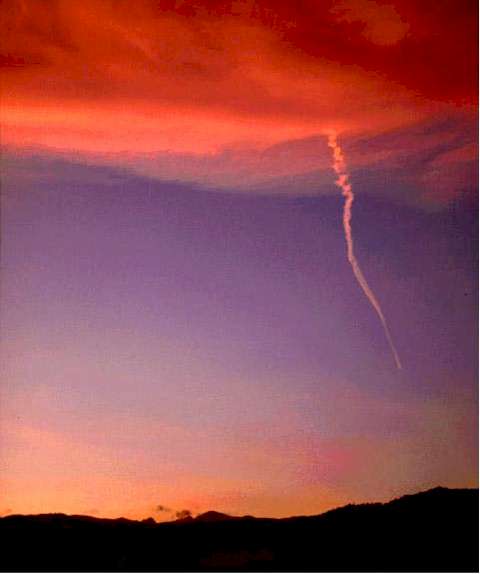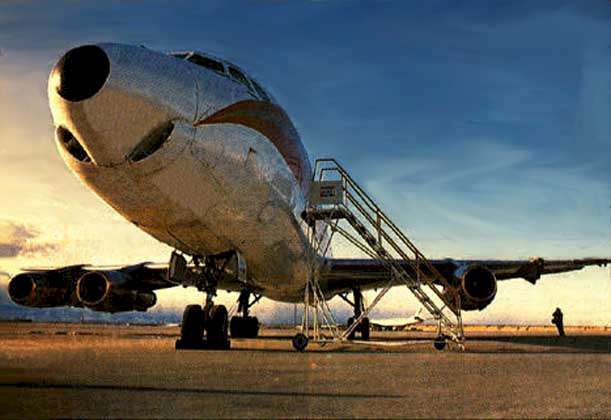That Position Has Been Taken
Air Traffic Out of ControlThe more traffic at an airport, the better it is handled. - cliché, Great Airline Quotes
NASA recently flight-tested an advanced jet engine able to reach seven times the speed of sound. Talk was heard of hypersonic airliners zooming from New York City to Los Angeles in 45 minutes. If such a flight were made today, however, chances are good that the plane would be forced to circle over LAX for a few hours before it could be cleared to land. As the numbers of airline passengers and flights increase, the nation's air traffic control (ATC) system is being stretched beyond its limits. With one in four flights expected to be late to the gate this summer, flying has become one of the more consistently annoying aspects of modern American life. Estimates indicate that delays cost airlines and air travelers some $5 billion in lost productivity every year. Along with inadequate runway capacity and the overscheduling of flights, the ATC system is a major culprit in this woeful display. And it's only going to get worse as today's US flying public grows from 670 million a year to more than a billion within a decade. The Federal Aviation Administration's abortive attempt to modernise the network of radars and computers that tracks air traffic, an initiative that dates back to the early 1980s, has become one of the worst debacles in the history of information technology. The original $12-billion project to install automation equipment, scheduled for completion by 1991, never met its targets, while wasting $2.8 billion in the process. As a result, current ATC computer technology is still horribly out-of-date. During the Clinton administration, proposals to remove the operation of the system from the bureaucratic hands of the FAA and run it as a business got nowhere. Now growing air gridlock has returned the issue to centre stage-and the Bush administration is giving commercialisation a closer look. This time, however, the debate is conditioned by the experience gained from commercialisation programs beyond US airspace. Nearly 20 nations have spun off their ATC systems into nonprofit or self-supporting government corporations. Key to these efforts is to let the new entity serve as traffic cop while the government maintains safety. Operations are supported by user fees similar to those paid today by airlines and general aviation pilots. One oft-cited model is Canada. There a nonprofit company, Nav Canada, has managed to cut delays and expenses even as it upgraded technology. It is run by a stakeholder board of aviation interest groups that has structured fees to better balance user demand with airport capacity. ATC commercialisation could permit the faster implementation of free-flight technology, which would let planes fly more direct routes. Currently aircraft are funneled into single-Iane highways in the sky. One way to free up restricted flight paths is to use Global Positioning System satellites to locate aircraft precisely and then broadcast this information to other planes and controllers on the ground. If the Bush administration decides to push ahead, it will most likely encounter the same objections that plagued its predecessor: that a commercialised ATC might protect the bottom line at the expense of safety or that other countries offer poor models for the busy US system. True, negotiating the crowded airspace over Chicago or New York may be different from flying over Calgary or Quebec. But lessons from elsewhere still merit careful scrutiny to assess their applicability here. Despite protestations to the contrary, it's clear that the FAA isn't up to the job. Source: The Editors, Scientific American July 2001
Airline System Gets "Very Fragile" AgainYou land a million planes safely, then you have one little mid-air and you never hear the end of it. - Air Traffic Controller, NY TRACON, Westbury, Long Island: by Dan Reed Recession and terrorism nearly cleared the USA's skies and airports in 2001, but congestion - with all its aggravations - is returning to the lives of air travellers. The US Department of Transportation's key statistical indicators of congestion - late arrivals, cancelled flights, taxi-out times, runway delays and mishandled bags - all rose in 2004. Each had bottomed out in 2002 or 2003. Taxi-out times and runway delays last year returned to their peak levels of 2000, while other indicators remain below where they were during the last travel boom. The annual increases in 2004 reflect the addition of flights as airlines increase capacity to meet rising demand. Today, there are 29,564 scheduled commercial-jet departures, up 9% from two years ago. Total flights still lag behind January 2001 by 7%. In an interview, Federal Aviation Administration chief Marion Blakey said air traffic is coming back to pre-September 11 levels but is doing so "in different patterns, and with different characteristics" than before. Two big hub operations at St Louis and Pittsburgh have closed in the past two years, and a third, Delta's at Dallas/Fort Worth, closes this month, reducing the operational burdens there. But low-cost carrier and regional jet growth elsewhere more than offsets that. "Clearly, we are seeing rising congestion. Our forecasters have been saying all along that's where it's going," she says. Government statistics don't tell the full story, says Basil Barimo, vice president of operations and safety at the Air Transport Association, the industry's main trade group. Late arrivals would be even higher if airlines had not lengthened many of their published flight times. "A flight that used to take an hour may not be an hour flight anymore - it's an hour-and-a-half flight," Barimo says. "It shows up as an 'on-time arrival.' But passengers aren't getting to their destination as fast" as they used to. Congestion, and its attending problems, are likely to get worse. Congestion increases with industry capacity, and airlines' capacity is expected to grow nearly 7% this year. That's enough to make up for even the possible shutdown of the most endangered of the big carriers, US Airways. Though weather-related disruptions are beyond the airlines' control, their ability to recover quickly is hampered by rising congestion, says industry consultant Jon Ash at InterVistas-ga2. "The system is becoming very fragile again, like it was in the late 1990s," he says. When anything goes wrong, the number of passengers and flights affected, and the associated costs, quickly skyrocket. Complicating the situation: The big, money-losing network carriers continue to cut jobs. When disruptions arise, they no longer can throw armies of workers into resolving the problems. FAA chief Blakey notes that problems would be much worse if not for recent improvements to the air traffic system. Eight new runways have opened at major airports in the past 5 years, and 7 more are scheduled to open by 2010. The FAA has imposed scheduling changes at Chicago O'Hare, the system's biggest choke-point. And significant new air traffic control technologies are starting to go online. But no one expects the technology and runways to keep up with growing demand. Ash says the federal funding mechanism for airport and airways expansion in the USA "is fundamentally broken." Barimo agrees. Even Blakey allows that the raising and spending of aviation taxes will need "a hard look" before the law expires in 2007. One big problem, she says, is that funding is tied to what passengers pay for tickets. But fare prices are falling and aren't likely to rise much in the future. Contributing: Barbara Hanse Source: www.usatoday.com 10 January 2005
Fixing America’s AirlinesMyanmar Air Traffic Control: Hotel Bravo-Bravo Romeo Alpha, what is your departure point and destination? Brian Jones: Departure point - Château d'Oex, Switzerland. Destination - somewhere in northern Africa Myanmar Air Traffic Control (after several seconds of silence): - Brian Jones and unknown controller, FAA Plan to Handle Air Traffic Control Retirements Rebukedby Elizabeth Shogren and Jennifer Oldham Washington - With three-quarters of the United States' air traffic controllers expected to retire over the next decade, the Federal Aviation Administration on Tuesday announced plans to hire 12,500 replacements to become the next generation of workers charged with safeguarding the skies. As part of the plan, the agency expects to shrink the time it takes to train controllers from the present 3 - 5 years to only 2 - 3. It also will offer some current controllers an opportunity to continue working past the mandatory retirement age of 56. The union that represents all 15,000 FAA air traffic controllers harshly criticised the government's blueprint as inadequate. The staffing challenge facing the FAA is a legacy of President Reagan's decision to fire more than 10,000 striking air traffic controllers in one day in 1981. Their replacements will become eligible to retire en masse during the next 10 years. FAA officials said the problem is complicated by tight federal budgets caused by expansive deficits and the war in Iraq. National Air Traffic Controllers Association President John Carr said the Bush administration had delayed dealing with the approaching staffing problem, and as a result, there are already personnel shortfalls. He said the shortage of air traffic controllers would become more critical before the agency is able to train replacements. Although 500 controllers left the FAA during the last year, Congress appropriated enough money in 2004 to train only 13 new air traffic controllers, according to Russ Chew, the FAA's chief operating officer. But Chew, countering the union's criticism, said, "If we execute this plan, we will not be short of certified air traffic controllers when we need them." Representative John Mica, Republican - Florida, chairman of the House subcommittee on aviation, predicted that Congress would be more likely to provide funds for training controllers now that the FAA has proposed an "excellent blueprint" for addressing the staffing turnover. But Representative Peter DeFazio of Oregon, the ranking Democrat on the subcommittee, criticised the administration for failing to address the question of how to pay for the new controllers' training. "There is one glaring omission in this report - funding," said DeFazio. Congressman Mica also applauded the FAA for coming up with a policy that would allow some controllers to stay on the job after age 56. The plan would permit controllers to obtain annual waivers of the mandatory retirement date if they are exceptional performers and in good health. But the union's Carr said allowing controllers to stay on the job after 56 was one of the many flaws in the government's plan. He said the requirement to retire at 56 reflects that sight, hearing and ability to exercise 3-dimensional thinking decline with age. It would be risky for the FAA to allow controllers to work "beyond their prime air traffic controlling years," Carr said. Union officials also criticised the agency's proposal to allow more controllers to work part time and on split shifts to help deal with the crunch, and Carr expressed scepticism that the FAA can effectively reduce training time. They also scoffed at a suggestion by FAA officials that using more simulators would reduce training time, saying that the FAA has not asked Congress for money to buy more. They also said the assertion that controllers can be trained more quickly neglects the reality of the demanding on-the-job training controllers experience. Source: www.contracostatimes.com Wednesday 22 December 2004 via The Los Angeles Times © 2004 all rights reserved
Aircraft NavigationIt's not a testosterone-driven industry any longer. Success is making money, not in the size of the airline. - Gordon Bethune, Chairman and CEO, Continental Airlines, 1996
Newark - When American mail planes wanted to fly at night in the 1920s, they used to get farmers to light bonfires to help them find their way. 7; In-flight navigation has moved on since then. With the aid of the Global Positioning System (GPS) - a network of 24 satellites maintained by America’s defence department - modern aircraft know their location to within a few tens of metres. But even GPS is too inaccurate, and thus too risky, for use during take-off and landing - the critical minutes in which 50% of all aircraft accidents occur. Until now. On 21 September, a Continental Airlines Boeing MD-80 flew from Washington, DC, to Newark, New Jersey, and then on to Minneapolis, landing with the aid of "differential" GPS equipment (DGPS). This technology (which is widely employed for such things as navigation in harbours with narrow channels) uses a fixed ground station to compensate for the inaccuracy of pure, satellite-based GPS. The ground station calculates the difference between its known location and where the satellites say it is, and beams a correcting signal to incoming aircraft - allowing them to land with pinpoint accuracy. Although the Instrument Landing System (ILS) used for precision take-offs and landings at many airports today is almost as accurate, DGPS has many other advantages. For a start, says Michael Beamish, president of Pelorus (a Canadian company that is one of the new landing system’s suppliers), it allows aircraft to make better use of airspace. ILS guides planes using radio beams sent out by two beacons (one at each end of a runway). This means that aircraft have to make a long, straight approach at a fixed angle. But DGPS-guided planes are not bound by straight beams. They can make curved approaches from anywhere, avoiding residential areas and landing at airports that are awkwardly located between buildings or mountains. Better still, DGPS could help reduce congestion. Because of the risk that ILS beams might be reflected by nearby aircraft and cause confusion, planes waiting to land have to stay well apart. Switching to DGPS would allow them to queue closer together and land faster, with no greater safety risk. That could mean 20% more landings per hour, according to Mark Howes, head of the airport systems division at Honeywell (Pelorus’s partner in the venture). DGPS is cheaper, too. A single ground station costs $600,000 and can cover several runways - or even several airports - whereas ILS beacons cost $2m per runway. So, after some dithering, the aviation world now seems to be welcoming DGPS. The International Civil Aviation Organisation (ICAO), part of the United Nations, has dropped its support for a rival microwave-based system, MLS, and expects to recommend DGPS as a global standard next year. After a slow start, America’s Federal Aviation Administration (FAA) is also embracing DGPS, certifying it (for limited landing conditions) at Newark and Minneapolis-St Paul. By next autumn, 16 other airports are expected to have installed ground stations, and eight big airlines (including United and American) will have started equipping their fleets with DGPS receivers (which cost around $140,000 per aircraft). But a cloud is looming. The development of satellite-based mobile-telephony is creating demand for new bits of the radio spectrum. The frequency range that GPS uses - around 1.6 gigahertz - is attractive to mobile-telephone firms because it is unaffected by weather. Although most countries are careful to keep nearby frequencies clear, the ICAO is concerned that heavyweight telecoms operators may try to encroach on them for mobile satellite-phones - which could then interfere with GPS. There is also concern that, despite this vulnerability to interference, GPS could displace MLS and ILS completely - leaving aviators without a backup. As James Oberstar of the Senate Transportation Committee warns: "Even Charles Lindbergh flew over the Atlantic using a compass, a gyroscope and a radio." Source: The Economist 26 September 1998 © 1995-2001 The Economist Newspaper Group Ltd
Turbulence PrimerThe similarity between air traffic controllers and pilots?
Contrail indicating turbulence in a mountain wave over Boulder, Colorado by Parviz Moin and John Kim Practically all the fluid flows that interest scientists and engineers are turbulent ones; turbulence is the rule, not the exception, in fluid dynamics. A solid grasp of turbulence, for example, can allow engineers to reduce the aerodynamic drag on an automobile or a commercial airliner, increase the maneuverability of a jet fighter or improve the fuel efficiency of an engine. An understanding of turbulence is also necessary to comprehend the flow of blood in the heart, especially in the left ventricle, where the movement is particularly swift. Close-up ViewBut what exactly is turbulence? A few everyday examples may be illuminating. Open a kitchen tap only a bit, and the water that flows from the faucet will be smooth and glassy. This flow is known as laminar. Open the tap a little further, and the flow becomes more roiled and sinuous - turbulent, in other words. The same phenomenon can be seen in the smoke streaming upward into still air from a burning cigarette. Immediately above the cigarette, the flow is laminar. A little higher up, it becomes rippled and diffusive. Turbulence is composed of eddies: patches of zigzagging, often swirling fluid, moving randomly around and about the overall direction of motion. Technically, the chaotic state of fluid motion arises when the speed of the fluid exceeds a specific threshold, below which viscous forces damp out the chaotic behaviour. Turbulence, however, is not simply an unfortunate phenomenon to be eliminated at every opportunity. Far from it: many engineers work hard trying to increase it. In the cylinders of an internal-combustion engine, for example, turbulence enhances the mixing of fuel and oxidizer and produces cleaner, more efficient combustion. And only turbulence can explain why a golf ball's dimples enable a skilled golfer to drive the ball 250 meters, rather than 100 at most. Parviz Moin and John Kim worked together in the early 1980s at the National Aeronautics and Space Administration Ames Research Center. Moin is now Franklin and Caroline Johnson Professor of Engineering at Stanford University and director of the Center for Turbulence Research there. His work lately has been on turbulence control, on the interaction of turbulence with shock waves and on noise generated by turbulent flows. Kim is Rockwell International Professor of Engineering at the University of California, Los Angeles. Much of his recent work has been in the application of neural networks to the control of turbulence. Source: Scientific American January 1997 photo source www.noaa.gov
Things That Go Bump in Your FlightAmericans have an abiding belief in their ability to control reality by purely material means... Airline insurance replaces the fear of death with the comforting prospect of cash. - Cecil Beaton, It Gives Me Great Pleasure, 1955
Jet lands minus engine, wing tip: this DC-8 cargo jet made a safe emergency landing at Stapleton Airport in Denver New Sensing Technologies Could Improve Air Safety by Providing Advance Warning of TurbulenceAlong with dodgy food, cramped seating and screaming infants, turbulence is one of the banes of modern air travel. At best, an airliner that encounters a pocket of swirling air experiences nothing more than a mild shaking. At worst, the result can be violent jolts that send passengers, food carts and luggage flying. In the past 15 years, such incidents have injured 850 people, 70 seriously, and caused three deaths. The annual cost to airlines in compensation claims, aircraft damage and accident investigations has been estimated at $100m. Some passengers are so terrified they vow never to fly again. Avoiding turbulence is a somewhat haphazard business. Pilots do their best to fly around storms and to steer clear of turbulent areas reported by aircraft further along the route. But a series of experiments that has just finished in Colorado could eliminate some of the guesswork, by enabling airliners’ existing radar systems to pick up signs of the most common kind of turbulence, called "convective" turbulence, with just a simple software upgrade. The radar systems in question are currently used to detect an even more undesirable atmospheric condition called wind-shear. This dangerous phenomenon occurs during a storm, when a rapidly descending column of air hits the ground and spreads out. An aircraft flying into such a column experiences a headwind, followed by a downdraft and then a tailwind. If the aircraft is flying at a low altitude, the sudden tailwind can rob it of lift and cause a crash. Wind-shear is detected by transmitting a stream of radio pulses in front of the aircraft. By analysing a tiny change in frequency, called the Doppler shift, caused when the pulses bounce off moving raindrops, it is possible to work out how fast the drops are moving - and hence the pattern of air movement in front of the aircraft. An alarm sounds if the characteristic sign of wind-shear, which is a headwind with a tailwind behind it, is detected. After several crashes in the 1970s and 1980s, such radar systems are now installed on many modern airliners. These systems are, however, used only at altitudes below 700m (2,300ft) and are switched off during the rest of the flight. This set Larry Cornman, an atmospheric scientist at the National Centre for Atmospheric Research (NCAR) in Boulder, Colorado, thinking. Could not the same equipment be put to use during flight to detect turbulence? In theory, the answer is yes. Raindrops in calm air are all carried along at the same speed and in the same direction, so radio pulses bouncing off them are all Doppler-shifted by the same amount. Raindrops within a turbulent region, in contrast, have a wide range of speeds and directions as they are tossed around, resulting in a wide range of Doppler shifts. So by correctly processing the readings from the radar system, it ought to be possible to detect approaching pockets of turbulence. Stirring StuffTo test this theory, three aircraft have spent the past few weeks flying around in Coloradan thunderstorms, looking for trouble. Two of the aircraft are research craft fitted with a standard off-the-shelf wind-shear radar (one made by AlliedSignal, the other by Rockwell-Collins). The third aircraft, which flies in front of the other two, is an armoured storm-penetration plane that takes atmospheric readings. Whenever the third aircraft reports a pocket of turbulence, the radar readings from the other two are scrutinised to see if they contain evidence that would have predicted its occurrence. In this way, Dr Cornman hopes to devise new software that will enable existing radar systems to provide advance warning of turbulence. As little as one minute’s warning would be enough to prevent the passengers and crew from being taken by surprise. The first systems could be operational within two years. Only about 60% of turbulence, however, is associated with storms. Radar systems cannot, for example, detect "clear-air turbulence" (CAT), a particularly nasty variety that, as its name suggests, occurs unexpectedly in clear air. Even with no raindrops around to bounce radar pulses off, CAT can still be detected using a light-based radar or "lidar", which measures how light from a laser beam is scattered by tiny airborne particles called aerosols. A lidar-based CAT detector was tested successfully last year by America’s space agency, NASA, and further tests are planned for later this year. Yet another kind of turbulence is terrain-induced, and causes problems at airports in mountainous regions. But it too can be predicted. Using readings from an instrument-equipped plane in the air, in combination with ground-based windspeed sensors and radars, it is possible to build a mathematical model for a particular airport that can then be used to predict turbulence solely from measurements taken on the ground. Such a system is already in place at Hong Kong airport, and NCAR researchers are now testing a more advanced system at Juneau, Alaska, an airport where terrain-induced turbulence is a particular problem. It seems, then, that there are technical fixes in the works that will do much to mitigate the effects of turbulence over the coming years. If only the same could be said of other impediments to pleasant air travel. Source: The Economist 3 June 1999 © 1995-2001 The Economist Newspaper Group Limited. All rights reserved; photo source: www.noaa.gov
Passengers, Crew Hurt as Turbulence Jolts Jumboby Ainsley Thomson A crew member was knocked unconscious and several passengers injured when a United Airlines jumbo hit severe turbulence over the Pacific. The aircraft was forced to make an emergency detour to Auckland, landing about 11pm. The flight from Sydney to San Francisco was four hours into its journey when it hit "clear air" turbulence. Passenger Julie Greenwood, from San Francisco, said the turbulence lasted about 30 seconds. "It was like and earthquake in the air I was lifted out of my chair twice." She said the incident was terrifying and was especially concerned when her 18 month old daughter Stella briefly passed out. Mary Brander, 77, from Sydney, said she was lucky to be sitting down when the aircraft rocked violently. "It was so unexpected the bottom seemed to be falling out of the plane. One minute we were in clear blue sky and it hit." The worst injured were at the rear of the plane, including a flight attendant and a person who was in a toilet. Julie Greenwood said a female attendant was knocked out and badly injured when she was pinned under a food trolley. She suffered leg fractures and was admitted, along with three passengers and another crew member, to Middlemore Hospital early today. The others had minor injuries, including cuts and bruises. Crew, helped by three doctors and a vet on board the Boeing 747-400, treated some of the injured as the aircraft headed for Auckland. Four ambulances were at Auckland Airport to assess the passengers when Flight UA 862 landed. It was carrying 269 passengers and 21 crew. The aircraft was over Tonga when the pilot decided to detour to Auckland, the closest large city with medical facilities. Airline officials said the decision was made for "passenger safety". The aircraft landed without incident. Passengers were taken through Auckland Airport and put up in hotels overnight. They are expected to continued their journey later today. The flight left Sydney at 3:35pm (NZ time) and turned back about 7:35pm. "Clear air turbulence" occurs when a plane hits a sudden change in air conditions in no cloud, much like a boat hitting a huge wave. It is sometimes associated with jet streams between Australia and Indonesia. In April 2000, seven Korean Air passengers and a crew member were injured when their New Zealand-bound airliner plummeted up to 100m. The Boeing 777 struck heavy clear-air turbulence about five hours after takeoff from Seoul. In 1996, a Singapore Airlines Boeing 747-400 hit severe turbulence over the Southern Alps, leaving 11 crew with moderate injuries, including a fractured wrist and broken arm. The plane plunged dramatically when it hit clear air turbulence in strong northwest winds at a height of 2440m. Four years ago, a 32-year-old Japanese woman died when a United Airlines flight dropped 300m on a flight between Tokyo and Honolulu. Eighty-three people, including nine attendants, were also hurt. Source: www.nzherald.co.nz 2 May 2002
The United passengers in the above article were told a new 747 had flown in from Los Angeles - the plane that hit turbulence, they were told, was going to undergo extensive x-rays before being able to fly again. So the passengers left Auckland the following day in the new plane - or rather they didn't. The take-off was delayed four hours while passengers waited on board, and was then abandoned after the pilot announced he had heard a "strange noise." On Friday, the turbulence plane was back - complete with broken monitors and tray tables and wine spills on the seats. Many of the passengers refused to get back on. The aircraft took off with the passengers who remained. It had been in the air for 30 minutes when the captain told passengers it had a serious mechanical problem, was losing air pressure and leaking fuel and needed to turn back to Auckland. A related problem meant the flaps, which help the plane land, might not be operating and the plane needed to go to "secondary power". The captain told flight attendants - some of whom were on the flight that struck turbulence - to move to the seat rows next to exit doors. He told passengers not to be alarmed, and said emergency vehicles would meet the plane at Auckland. "Everyone was pretty tense. My wife was freaking out," said one businessman. Some passengers have opted not to try the 4th flight...
To view other articles related to flying including history, unusual flying machines, hot air balloons, skydiving, gliding, problems, airports, turbulence, pilots, crashes, the
Paris Air Show, the future, blimps, space travel, solar sails and more, clicking the "Up" button below takes you to the Table of Contents for this section on Flight. |
 Animals
Animals Animation
Animation Art of Playing Cards
Art of Playing Cards Drugs
Drugs Education
Education Environment
Environment Flying
Flying History
History Humour
Humour Immigration
Immigration Info/Tech
Info/Tech Intellectual/Entertaining
Intellectual/Entertaining Lifestyles
Lifestyles Men
Men Money/Politics/Law
Money/Politics/Law New Jersey
New Jersey Odds and Oddities
Odds and Oddities Older & Under
Older & Under Photography
Photography Prisons
Prisons Relationships
Relationships Science
Science Social/Cultural
Social/Cultural Terrorism
Terrorism Wellington
Wellington Working
Working Zero Return Investment
Zero Return Investment